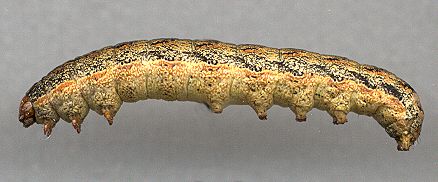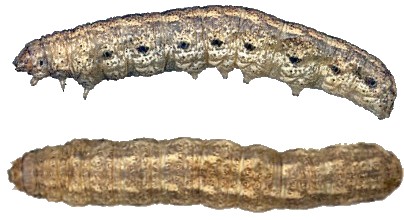Black Cutworm, Granulate cutworm, Variegated cutworm
 Scientific Name
Scientific Name
Agrotis ipsilon, Feltia subterranea, Peridroma saucia
Hosts
Cutworms are general feeders and attack a wide range of plants. All common turfgrasses are susceptible to damage.
Symptoms
Larvae feed at night on the leaves and crown and may cut off plants near the soil line. During the day, they are found hiding in holes, under debris, or under thatch near the surface of the soil.
Life Cycle
Cutworms overwinter as eggs, larvae, or pupae, depending on the species, and damage to turf can occur from late February to early October. Army cutworms overwinter as larvae, feed early in the spring, and have one generation per year. Damage in February and March is most likely to be caused by this species. Claybacked and dusky cutworms also overwinter as larvae and have one generation per year, but the larvae develop later in the spring. They and the bristly cutworm are most likely to cause damage in April and May. Bronzed cutworms overwinter as eggs and have one generation per year. Damage is most likely in May. Variegated and black cutworms overwinter as pupae and have several generations per year. Variegated cutworm damage is most likely in May while black cutworm damage is usually reported in the late summer or fall (August and September). Local populations of some species are augmented by migration of moths. Black cutworms migrate north in the spring and army cutworms migrate from the mountains in Colorado in the fall.
Description
Cutworm adults are medium sized moths with a wing-spread of 1 to 2 inches. Most species
are brownish or grayish in color with various darker or lighter markings  on the front wings. The larvae are black, gray, or brown caterpillars that are about
1 1/2 inches long at maturity. Some species have darker or lighter spots or stripes
on the body. At least 8 species are known to damage turf in Oklahoma. The black cutworm
- Agrotis ipsilon, is the most commonly reported and the bronzed cutworm - Nephelodes minians, variegated cutworm - Peridroma saucia, and bristly cutworm - Lacinipolia renigera, cause problems in some years. The granulate cutworm - Agrotis subterranea, dusky cutworm - Agrotis venerabilis, and claybacked cutworm - Agrotis gladiaria, may damage turf in years when they are abundant.
on the front wings. The larvae are black, gray, or brown caterpillars that are about
1 1/2 inches long at maturity. Some species have darker or lighter spots or stripes
on the body. At least 8 species are known to damage turf in Oklahoma. The black cutworm
- Agrotis ipsilon, is the most commonly reported and the bronzed cutworm - Nephelodes minians, variegated cutworm - Peridroma saucia, and bristly cutworm - Lacinipolia renigera, cause problems in some years. The granulate cutworm - Agrotis subterranea, dusky cutworm - Agrotis venerabilis, and claybacked cutworm - Agrotis gladiaria, may damage turf in years when they are abundant.
Control
Please contact your local county extension office for current information.
